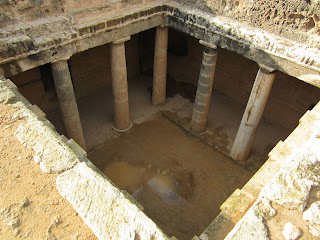I’ve certainly enjoyed writing this blog so far – it’s given me a bit of perspective on my trip as I’ve been experiencing it, it’s going to be a useful record later on when I start having difficulties remembering what I did and in what order, and of course it’s given me valuable writing experience – normally I’m too lazy to do all the writing I should! But the other important thing it provided was education and information. I promised when I started writing this blog that there would be interesting historical content, and I’ve made a special effort to research (usually with wikipedia) everything I don’t know, and I truly feel as though my historical knowledge is far greater now than it was three months ago. But I want to do something with that knowledge too, and I want to make this blog something more than a simple journal nobody will be interested in in a year’s time. I want to create something unique, interesting and informative, and I think I’ve come up with just the thing.
The seeds for the idea began months ago when I was planning the trip. It was apparent to me then that this would be a trip not just across countries but also back in time. Of course the path hasn’t been straight back – there has been more than a little jumping back and forth, but broadly speaking you could say that the important historical points I’ve experienced were earlier and earlier in time as I progressed through the countries. In Ireland I learned about the “troubles” of the 20th century and the potato famine of the 19th, in Scotland I learned about their battles with the English in the 16th century, then I headed to Venice, which was a very important power in the 15th century, and then Florence which was pretty much the centre of the Renaissance in the 14th century. Rome followed that, of course the capital of the Roman empire until the 4th century. After Italy I travelled to Greece, the predecessor to Rome and the birthplace of Western civilization. With Athens being one of my first ports of call I gradually headed backwards on the mainland until I reached Mycenaea, the civilization that flourished before the classical Greek. After that I headed south to Crete, where the Minoans built their palaces hundreds of years before Mycenaea. After a short regress to Classical and Hellenistic times in Turkey, I visited Troy, a city that had stood in some form or another since 3000 BC. Finally, before bouncing back toward the present, I got a taste of the Sumerian civilization in the Archaeology museum of Istanbul, which began arguably as early as 5000 BC.
It’s an interesting phenomenon, and though originally not intentional is certainly potential fodder for something creative. I think it was in Greece or Turkey that the concept for the form of this project came to me. Some time ago I read a book called “The Ancestor’s Tale” by Richard Dawkins. Using Chaucer’s “The Canterbury Tales”, in which many pilgrims meet up and have a story telling competition as they travel to Canterbury Cathedral, as a template he writes a kind of reverse history of evolution with various organisms of increasingly distant relation meeting up with their common ancestors. One thing I liked about this format is the unique perspective which a backwards history affords. In an important way it makes the history much easier to digest. Having read a couple of other books that tried to tackle the history of evolution on Earth using a more traditional forward chronology I found Dawkins’ approach much more effective. Instead of beginning in an alien environment with no reference point to what we know we must wait until the end to discover how it all relates to us, and by then we’ve already forgotten many of the important points. A backwards history, however, allows us to ease out of our comfort zone and still retain a sense of relevance and continuity. It also helps us to grasp the scope of the time frame involved. Throwing a huge number, like 3000 BC, at someone is a lot more effective when you already understand all the things that have happened between then and now. I already tried a condensced version of this, if you will remember, in my post about Mycenaea.
So that is what I propose to do. Using the context of my trip I will try in a number of posts representing key periods in the history of Civilization as we know it to construct a reverse chronology. Wish me luck!






































